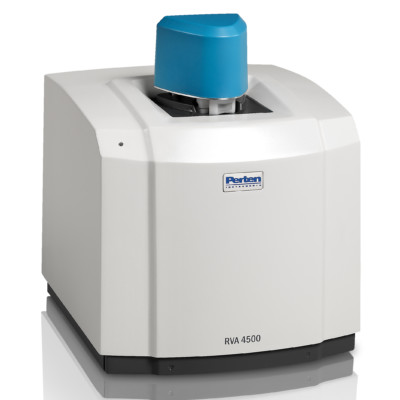
Rapid Visco Analysis
What is a Rapid Visco Analysis?
An Rapid Visco Analysis (RVA) is a quick, amylographic physical assessment of cereal-based products. This test is performed by the Rapid Visco Analyzer, which is a rotational (stirring) rheometer that measures apparent viscosity of starch-containing suspensions, and flour/water mixtures under variable and controlled heating (cooking), cooling, and shear stress conditions.1
- Sprout (preharvest) damage of wheat kernels
- Quality fingerprinting of cereal flours
- Pasting/gelatinization characterization of starchy ingredients
- Stability of emulsions and foams
- Water absorption/holding capacity
- Assess starch damage (e.g., due to milling)
- Enzymatic activity
- Stability to freezing and thawing
The RVA device has a software that allows recording and plotting of the behavior (curve) of the product being analyzed as a function of temperature (°C), analysis time (min), and apparent viscosity (cP-Centipoise).
The obtained curve of the sample as a function of the apparent viscosity, temperature, shear stress, and time, allow to visualize the points where physical transitions and changes in the texture of the sample take place (e.g., gelatinization, retrogradation and re-ordering of starch molecules, and formation of final viscous gel/paste).
Relevance
An RVA is an important R&D tool. It allows for the physical characterization of flour-based products. The viscosity changes produced when heating and cooling the starch in water allows determination of the minimum energy required to cook and process the sample/product being tested, and the appropriate conditions for desired consistency and thickening effect.
An RVA is also a practical and important baking quality indicator, since there is a tight relationship between rheological and mixing properties of flour/water mixtures, e.g., dough strength/torque, water absorption, shear and temperature stability, falling number, and dough extensibility; all of them correlating with each other.3
Application
A Rapid Visco Analyzer consists of a stirring paddle attached to a motor whose shaft rotates at constant speed, and the current (energy) required to drive it is monitored continuously by a microprocessor. An aluminum sample container is filled with a certain mass of powdered product and volume of water, and placed to surround the paddle, after which the motor is started.
A metal conductor at high temperature (>90°C) rapidly heats the mixture until the sample reaches the gelatinization temperature of the starch. Depending on the product, the test can take 2–15 minutes to be completed. Finally, the power required by the motor correlates directly with the apparent viscosity.2
In order to draw proper conclusions about the quality and technological properties of foods being tested with an RVA, intrinsic and extrinsic factors must be taken into account:
- Intrinsic: Water content; amount and nature of total solids (proteins, complex carbohydrates/hydrocolloids, soluble sugars, fats, and minerals); amylose/amylopectin ratio; native presence of hydrolytic enzymes (e.g., pectin polygalacturonase, α/β amylases, maltase-glucoamylase)
- Extrinsic: Processing conditions (e.g., additives, addition of yeasts, temperature, acidity, pressure)
Steps for an RVA
- Properly calibrate the equipment.
- Configure the test parameters (shear, temperature, rpm, time) on the software menu.
- Prepare/weigh the sample (dry product).
- Enter relevant data regarding product moisture.
- The equipment software (based on a mass balance calculation) automatically pours the exact amount of water required to process the sample.
- Place canister inside the testing chamber.
- Run the RVA.
- Equipment automatically records and graphs data collected during test.
- Analyze data.
- Conclude and report.
Approved methods that make use of RVA
- AACC International Method 61-01.01 (Determination of the Pasting Properties of Rice
with the Rapid Visco Analyser) - AACC International Method 61-02.01 (Amylograph Method for Milled Rice)
- AACC International Method 76-22.01 (Pasting Properties of Oat—Rapid Viscosity Analysis)
- AACC International Method 76-21.01 (General Pasting Method for Wheat or Rye Flour or Starch Using the Rapid Visco Analyser)
- AACC International Method 22-08.01 (Measurement of α-Amylase Activity with the Rapid Visco Analyser)
References
- Perten Instruments. “Rapid Visco Analyser® (RVA) — Application and Method.” https://www.perten.com/Global/Brochures/RVA/RVA%20Method%20Brochure_20151110.pdf. Accessed 27 Feb 2018.
- Bourne, M.C. “Viscosity Measurement.” Food Texture and Viscosity: Concept and Measurement, 2nd ed., Academic Press, 2002, pp. 249–250.
- Smith, D.M. “Protein Separation and Characterization Procedures.” Food Analysis, 5th ed., Springer International Publishing, 2017, pp. 449–450.

